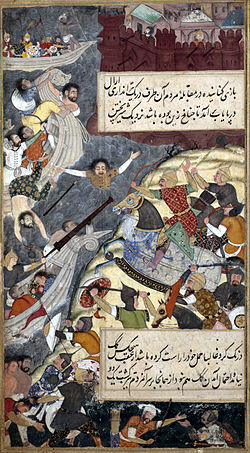Indus

The Indus River is the greatest river on the western side of the south Asian subcontinent. It is one of the seven sacred rivers for The Brahmans of Vedic period.[1] It was the birthplace of the early Indus Valley civilization. It flows through China (Western Tibet), India and Pakistan. It is one of the main rivers of the Indo-Gangetic Plain.
The river is 3180 km long. It is Pakistan's longest river. The river has a total drainage area exceeding 1,165,000 km2 (450,000 sq mi). Its estimated annual flow stands at around 207 km3 (50 cu mi), making it the twenty-first largest river in the world in terms of annual flow. It discharges about 6,600 cubic meters per second.
The word Indus and the cognate[2] word "Hindu" are derived from Sapta Sindhu (Sanskrit for "seven rivers") for the region is ancient. The Ancient Greeks used the word Indós; Hinduš was Old Persian; Sindhu in Sanskrit. Modern languages on the sub-continent use either Sindh (modern Sindhi) or Sindhu (ancient Sanskrit) or very similar words. The river's region's name came to be the name of the country India.[3]
River basin[edit]
Over 47% of the total area of the Indus drainage basin is in Pakistan and Pakistan-administered Kashmir. India has about 39%, Tibet has 8% and Afghanistan has 6% of the Indus basin catchment area.
The Indus water system of rivers comprises the main Indus and its major tributaries: the Kabul River and Kurram River on the right bank, and the Jhelum River, Chenab River, Ravi River, Beas River and the Sutlej on the left. The first two join the Indus soon after it leaves the mountains, and the others lower down in the plains. The whole of the Beas and the head reaches of the Ravi and Sutlej are in the Republic of India, while those of the Chenab and Jhelum lie mostly in the disputed Kashmir state.
The entire basin covers an area of about 384,000 square miles of open land, of which 204,000 lie in Pakistan. In addition, there are about 29,000 square miles which lie outside the Indus basin but are dependent on the Indus river system for their water requirements and irrigation supplies.
Without the Indus waters, agriculture in Pakistan would be very uncertain, because there is not much rain. Even now when Pakistan is being rapidly industrialised, it needs its water resources, because much of its industry uses agriculture produce for its raw materials. Almost all of the basin in Pakistan receives an overall rainfull of less than 15 inches, 60% of its area receiving less than 10 inches, while, 16% receives less than 5 inches. The rainfull is not evenly distributed throughout the year but is concentrated during the monsoons.
Course[edit]
Rising in western Tibet, the Indus runs at first across a high plateau, then the ground falls away and the river, dropping rapidly, gathering momentum and rushing north-west, collects the waters from innumerable glacier-fed streams, and runs north-west between the world's greatest mountain ranges, the Karakoram and the Himalayas. In Kashmir it crosses the United Nations cease-fire line and, in Baltistan District, enters Azad Kashmir. From here on it is Pakistan's river; Pakistan's first town on the upper Indus, Skardu, at 7,500 feet above sea-level, stands on a bluff near the junction of the Indus and one of its great right-bank tributaries, the Shigar. The majority of the people live in Skardu town; others inhabit small and scattered villages along the Indus and Shigar valleys, or tiny hamlets high on the surrounding mountains.
References[edit]
- ↑ "Sapta Sindvas The Land of Several Rivers" (PDF). Professor Aslam Khan.
- ↑ "Cognate" means descended from a common ancestor, of the same family, coming from the same stock or root. Shorter Oxford English Dictionary, vol 1, p337.
- ↑ Shorter Oxford English Dictionary vol 2, p989.
Other websites[edit]
- Blankonthemap The Northern Kashmir WebSite
- All About Indus River Pakistan Archived 2009-04-18 at the Wayback Machine
- Bibliography on Water Resources and International Law Archived 2011-02-09 at the Wayback Machine See Indus River. Peace Palace Libray
- Northern Areas Development Gateway Archived 2008-05-11 at the Wayback Machine
- The Mountain Areas Conservancy Project Archived 2016-03-03 at the Wayback Machine
- Indus River watershed map (World Resources Institute)
- Indus Treaty Archived 2005-12-20 at the Wayback Machine
- Baglihar Dam issue
- Indus
- Indus Wildlife
This article does not have any categories. Please add a category so that it will be placed in a dynamic list with other articles like it. (February 2022) |